The victorious conclusion of the East Pomeranian operation. Assault on Gdynia, Danzig and Kohlberg
After Rokossovsky and Zhukov’s armies reached the Baltic Sea and cut the Vistula Army Group, the troops of the 2 Belarusian and the right wing of the 1 Belorussian fronts turned without pause in the western and northeastern directions and began to liquidate separate groups of the eastern -Pomeranian grouping. Rokossovsky's troops received the task of finally destroying the 2 German army, which lost ground communications with the rest of the Vistula army group and cleared the northeastern part of Pomerania from the Nazis. Zhukov's troops were to finish off the remnants of the German 11 th army, pressed against the Oder and take the western part of Eastern Pomerania.
The headquarters of the Supreme High Command gave the troops of the 2nd Belorussian Front instructions for the defeat of German troops in the areas of Stolp, Gdynia and Danzig. The troops of the right flank of the front were to advance along the western bank of the river. It hung on Danzig, on the left flank - on Stolp, Lauenburg and Gdynia. For a faster solution to the problem, the Rokossovsky front was strengthened by the 1st Guards tank Katukov’s army from the 1st Belorussian Front. Katukov’s army was supposed to advance in the direction of Gdynia.
The 1 Belorussian Front was tasked with completing the clearance of the western part of Eastern Pomerania from the German forces and reaching the Oder in the area from the mouth to Tseden. After that, the main forces of the right flank of the 1 of the Belorussian Front were to go back to the Berlin direction. After the completion of the East Pomeranian operation, tank units were withdrawn to the reserve to replenish equipment and prepare for the decisive Berlin operation.
The German command, despite the severe defeat, was not going to surrender. The German army 2 continued to have large forces: 2 tank and 5 army corps - 7 and 46 tank corps, 18 mountain hunters, 23 and 27 army corps, in reserve were 55 minutes and 20 th army corps, total 19 divisions (including two tank), three combat groups and a significant number of other units and units of a special, educational, militia nature. Discipline in the army induced most severe methods. To scare almost all roads leading to Danzig and Gdynia, and in the cities themselves, a gallows was erected. The soldier was hung with signs saying “Hung up for leaving without permission”, “Hanging up for cowardice”, etc.
11-I German army was in the worst condition. Her units were fragmented and could mainly resist in certain localities turned into defense units. Parts of the 10 SS Corps and the Tettau corps were defending in the western and north-western directions. To the west of the Naugard, Mass and Stargard lines, the troops of the 3 and 39 and 2 army corps fought. The rapid development of the situation did not allow the German command to strengthen the forces remaining in Eastern Pomerania at the expense of the formations of the 3 tank army. On the contrary, parts of the 11 Army had to be withdrawn beyond the Oder in order to put them in order and organize a new line of defense. The Germans paid special attention to the defense of Stettin, a large industrial center of Germany. For this, they planned to keep Altdam.
The offensive troops of the 2 of the Byelorussian Front
Rokossovsky, in accordance with the instructions of the Stavka, threw the troops into a new offensive. On the left flank, the 19 Army, reinforced by the 3 Guards Tank Corps, struck in the direction of Stolp, Lauenburg and Gdynia. Later on, the 1-I Guards Tank Army was introduced into its offensive zone. The 134 th rifle corps of the 19 th army was to assist the 1 th army units of the Polish Army in the destruction of German troops in the area south of Kohlberg.
The 70 Army and the 8 Mechanic Corps attacked the Buttes, Gdynia. The right-flank 2 shock army, reinforced with a tank corps, advanced along the Vistula towards Danzig. The center's armies, the 65 and 49 armies, advanced in the northeastern direction, on Danzig and Zoppot (Sopot). The 3 Guards Cavalry Corps, which provided the left flank of the front strike group from the west, was instructed as they advanced the troops of the 1 Belorussian Front to Kohlberg, to advance on the Baltic Sea coast and gain a foothold on it.
On the morning of March 6, the troops of the 2 of the Byelorussian Front resumed their offensive on the entire front. Particular success was achieved by the Soviet troops on the flanks, where the defense of the enemy was broken through. On the right hose, Soviet troops launched an assault on Starogard. March 7 Soviet troops launched an offensive on the flanks, occupying more than 350 cities and towns. Starogard was liberated on the right flank, on the left wing - Shlava and Rugenwalde. Tankers began a battle for the city of Stolp. The 134 th rifle corps, having completed the destruction of scattered enemy groups south of Kohlberg, advanced to its eastern outskirts, establishing communication with the troops of the 1 Belorussian Front. Then the troops of the corps moved to join the main forces of their army.
Entering the battle on the left wing of the front 3-th Guards Tank Corps finally broke the enemy defenses. The German command, having lost hope of stopping the Soviet armies, began the withdrawal of troops in the position of the Danzig-Gdynia fortified area. The withdrawal of the main forces was covered by strong rearguards who tried to restrain the Soviet troops at the communications centers and destroyed the communication lines. In some places, German troops lingered on certain lines and put up stubborn resistance. Particularly stubbornly, the Germans resisted in the offensive zone of the right flank of the Soviet front, where they had previously equipped field-type positions.
March 8, parts of the 3 Guards Corps, together with the rifle formations that came up, took the second largest city in Pomerania after Stettin, a major industrial center and communications hub, Stolp. On the same day, a detachment of a tank corps was captured by Stolpmünde. On the approach to the city, the enemy's motorized column was crushed, which was to organize the defense of Stolpmünde.
At the same time, tank units continued to develop the offensive on Lauenburg and rapidly captured the crossings over the r. Lupov-Flisse. So the vanguard of the 2-th Guards Motorized Rifle Brigade seized a bridge in the area of Lupov. The detachment under the command of Captain Baranov’s Guard included the 3-th Guards Motorized Rifle Battalion, two mortar companies and two SAU batteries. Self-propelled guns destroyed the enemy's anti-aircraft guns, located directly on the road on both sides of the bridge, and the mortar gunners suppressed the German infantry's machine-gun points. Taking advantage of the weakening of the enemy’s fire and its confusion, submachine gunners quickly seized the bridge. Crossing captured intact.
March 9 troops of the Belarusian Front 2, overcoming the resistance of the enemy rearguard, continued the offensive. On this day, the 1-I Guards Tank Army launched an offensive. Soviet troops 8-9 March advanced on different sections from 10 to 50 km, and occupied more than 700 settlements, 63 railway stations, including the cities of Schönek, Buttes and Stolp. However, as the Soviet troops advanced toward Danzig and Gdynia and the front of the German defense was reduced, the density of the enemy’s battle formations increased. The Germans began to provide more powerful resistance. Therefore, in the following days, the pace of the offensive of the Soviet troops decreased markedly.
On March 10, units of the 3rd Guards Tank Corps launched an assault on Lauenburg. However, attempts by the 18th Guards Tank and 2nd Guards Motorized Rifle Brigades to take the city on the move did not lead to success. The Germans put up stubborn resistance, the battles took on a fierce and protracted character. Only when the infantry of the 19th Army approached in the afternoon, and artillery and aviation, Soviet troops were able to break into the city. During the fierce street fighting Lauenburg took. By the end of the day, the advancing troops of the left wing of the front, using the success of the tank units, advanced with battles to a depth of 30 km and took the cities of Carthouse, Lauenburg and Leba.
In the central sector, where troops of the 49 Army attacked together with the 1 Guards Tank Corps, the Soviet troops had to break through the strong defenses of the enemy. On the right wing the situation was even more difficult. The Soviet troops not only failed to advance, but also reflected numerous enemy counterattacks. The Germans threw a significant amount of armored vehicles into battle. As a result of a fierce oncoming battle, the 8-th Guards Tank Corps, supported by infantry of the 2-th Shock Army, smashed a strong enemy armored group.
March 11 infantry 19-th army and tank crews 1-th Guards Tank Army took the city of Neustadt. A large German garrison was crushed, about 1 thousand people surrendered. By the end of March 13, the left wing of the 2 of the Belarusian Front reached the front edge of the Danzig-Gdynia fortified area. On the left flank of the enemy, the coast of the Putziger-Vik Bay was cleared, the city of Putzig was occupied and the exit from the Putziger-Nerung (Hel) was closed where the German 55 army corps was blocked.
At this time, stubborn battles were fought on the central sector of the front in the offensive zone of the 49 Army and on the right wing of the front, where the 2 Army was launched from Danzig to the south. For two days, the troops of the 49 Army stormed the area of the village of Kvashin. By the end of 13 March, the village took. The troops of the right flank broke into the strong defense of the enemy and took a major stronghold of the enemy, the city of Dirschau. As a result, the troops of the right wing also reached the leading edge of the Danzig-Gdynia defense area. At the third stage of the East Pomeranian operation was completed.
Thus, the troops of the 2 of the Byelorussian Front advanced with battles from 35 to 100 km towards Danzig and Gdynia, where the main forces of the 2 German army were surrounded. During this time, such large cities and enemy strongholds as Spolp, Stolpmünde, Lauenburg, Starogard, Byutov, more than 700 settlements were occupied. Most of the eastern part of Pomerania was cleared of the Nazis.
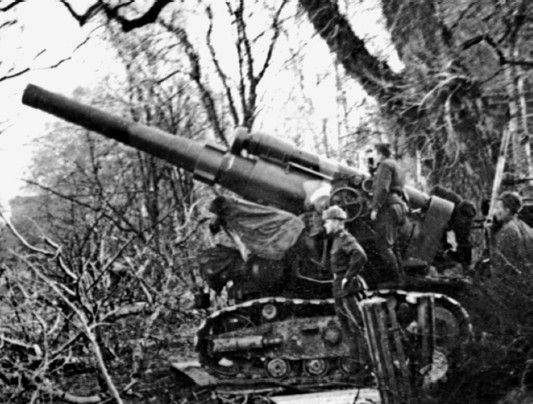
The shelling of Gdynia is carried out by a X-NUMX-mm howitzer B-203.
The offensive troops of the 1 of the Byelorussian Front
By Zhukov’s decision, the 3 th shock, 1 th Guards Tank armies and the 1 th Polish army should have cleared the Schiffelbein area from the Nazis, occupied the northern section of the Oder river line, and took Kolberg. The remaining troops of the right flank of the front were to clear the enemy of the territory in the zone of their offensive and go to the Oder. 2-I Guards Tank Army received the task to continue the attack on Cummin and Gollnov. The 61 Army had to take Altdam and reach the Oder. 47-I army to capture the area Greifenhagen and go to the Oder in the area Greifenhagen, Tsed.
After that, the troops of the two cavalry corps and part of the Polish army were to take up defense along the Oder and organize the defense of the Baltic coast. The troops of the 1 Guards Tank Army, after solving the task of eliminating the enemy in the area south of Shifelbayn, were placed at the disposal of the commander of the 2 of the Byelorussian Front. The rest of the troops were withdrawn in the Berlin direction.
By the end of March 7, units of the 1 Army of the Polish Army, the 3 Shock Army and the 1 Army Guards Tank Army destroyed the scattered enemy units blocked in the area south of Shifelbein. After that, the armies of the tank army were withdrawn from the battle and prepared to go into the zone of the 2-Byelorussian Front. The remaining troops continued their offensive in the area of Kohlberg, Treptow and Kammin.
In the area of Treptova, a significant grouping of the enemy was semi-circled: the remnants of four infantry divisions, the 7 Panzer Division, and the Holstein Panzer Division. 7-th Guards Corps corps blocked the German group path to the west and led the battle front to the east and northeast. The German command sought to withdraw this grouping for the Oder, and part of the troops were taken by sea to Western Pomerania. Zhukov ordered to speed up the rout of the enemy grouping in the Treptow area. The offensive was organized from several directions at once - from the south, southeast, east, southwest and west.
However, due to the mistakes of the command of the 3 shock army and the 7 rifle corps, which did not take measures to strengthen our troops in the western direction, where the Germans were torn, the Nazis were able to break through the ring of encirclement. The Germans left a barrier in the Treptov area, and the main forces threw on a breakthrough. 10-11 March during the fierce battles the Germans managed to reject our troops.
Thus, part of the semi-encircled enemy grouping was able to break through to its own. The other part was destroyed. At the same time, on the whole, the task of clearing the north-western part of Eastern Pomerania by Soviet troops was solved. Fighting to defeat the garrison of Kohlberg continued.
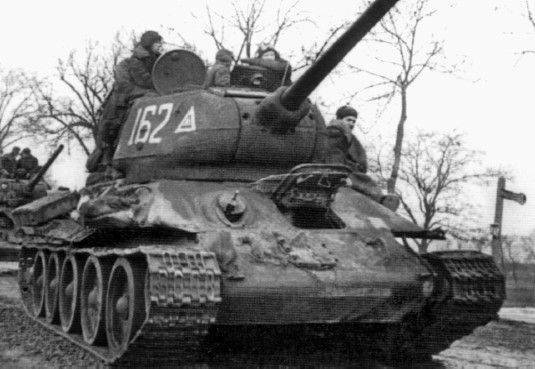
Tank T-34-85 2 of the Guards Tank Army on the outskirts of Stettin
In other areas, Soviet troops also continued to crowd the enemy. 7 March, our troops stormed the city of Gollnov. After the capture of the city of Gollnov, the tank formations of the 2 Guards Tank Army continued their advance in the southern and western directions. And the troops of the 3 shock army were withdrawn from the battle, transferring their combat sectors to Polish units.
The troops of the 61 and 47 armies, who were advancing on the Stöttin direction, had to break down the stubborn resistance of the enemy. Particularly fierce fighting went beyond the city of the Masses, where our troops had to storm literally every house. The 47 Army was unable to complete the task of capturing Altdam and cleansing the Oder in the zone of its offensive. In this direction, the Germans had a previously prepared defensive line, which had not only field fortifications, but long-term firing points. The troops defending him had a large number of artillery, tanks and assault guns. The terrain was inconvenient for the offensive - a lot of swamps, small water obstacles. It was possible to attack only along roads that were blocked by debris and minefields. The German flanks could not be bypassed, as they rested against natural obstacles: the left - into the lake Dammsher-see, right - into the river Oder in the Greifenhagen area.
The commander of the Zhukov March 12 temporarily stopped the offensive, giving the troops two days to prepare for an attack on the Altdam direction. It was necessary to prepare the assault on the last major enemy resistance in Eastern Pomerania. During this time, we conducted a thorough reconnaissance of enemy positions, reinforced the armies in this direction with four breakthrough artillery divisions, and attracted most of the assault and bomber aircraft for aviation training. To enhance the strike attracted compounds 2-th Guards Tank Army. At the third stage of the operation was completed.
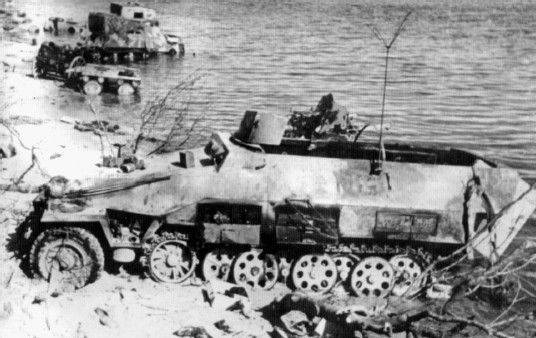
The commanding armored personnel carrier SdKfz.251, abandoned on the shores of the bay of Danzig
Summary of the third phase of the operation
Most of the territory of Eastern Pomerania was cleared of German troops. The entire East Pomeranian grouping of the enemy was split into several parts. In the area of Danzig and Gdynia, and on the Hel Spit, German 2 units were surrounded by troops. In the areas of Kohlberg and Altdamm, the remnants of the German 11 were blocked. The Altsdamm bridgehead had a special meaning for the Germans, as it covered Stettin. The presence of sea lanes allowed the German group in the Danzig-Gdynia fortified area not only to receive various supplies and materials, but also to ensure the transfer of troops by sea. However, the stubborn resistance of the enemy and the desperate attempts of the German command to hold the remaining bridgeheads in Eastern Pomerania, in order to hold down Soviet forces in these areas for as long as possible and gain time, could not change the situation. The German army lost the battle for Eastern Pomerania.
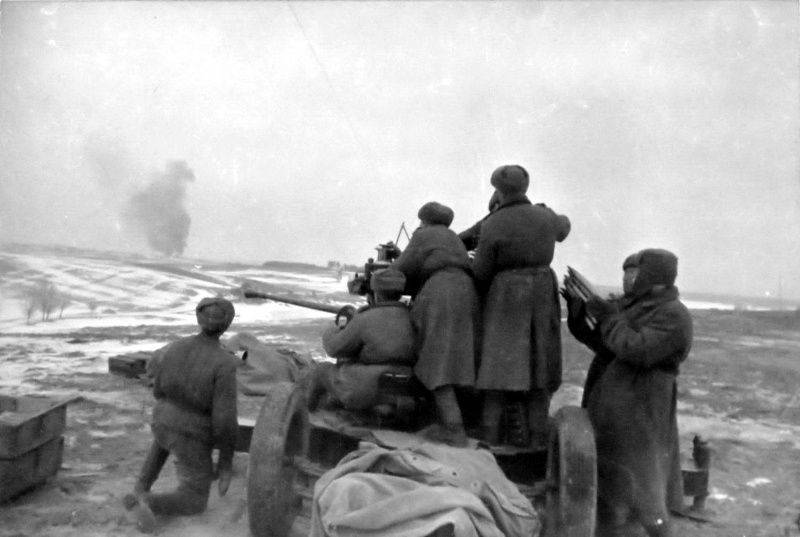
The calculation of Soviet anti-aircraft gunners firing direct fire from 37-mm automatic anti-aircraft gun in the area of Danzig
The fourth stage of the operation
Rokossovsky decided to deliver the main blow at Zoppot at the junction of the Danzig and Gdynia fortified areas, in order to cut the enemy grouping and crush it in parts. The main blow was inflicted by the forces of the 70 and 49 armies, reinforced by two tank corps. After the capture of Zoppot, both armies were to attack Danzig from the north and north-west. In order to prevent the German front ships from supporting the Danzig garrison, the troops of the 49 Army had to push long-range artillery to the bay.
The troops of the right wing of the front were to continue the attack on Danzig. On the left flank, the formations of the 19th and 1st Guards Tank Armies were to take Gdynia. A separate detachment was to occupy Hel Spit. The offensive of the ground forces was supported by all the aviation of the front, which was supposed to destroy the battle formations of the enemy and fight the German fleet.
The remaining troops of the right wing of the 1 of the Byelorussian Front were to complete the rout of the enemy groups in the Kohlberg and Altdamm area. The formations of the 1 Army of the Polish Army and the 2 Guards Corps corps were given the task of taking Kolberg. The troops of the 47 th, 61 th armies and the 2 th Guards Tank Army were to defeat the Altdam group of the enemy. The remaining troops of the right wing continued regrouping in the Berlin direction.
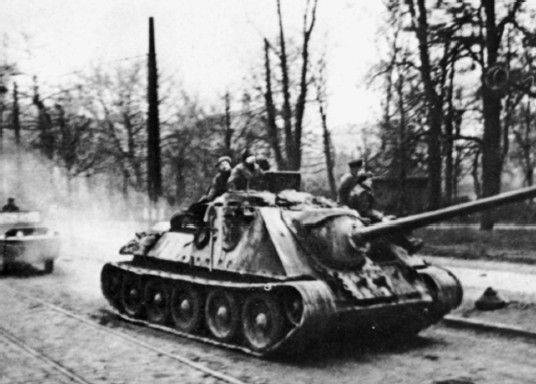
SU-85 self-propelled unit on the approaches to Gdynia
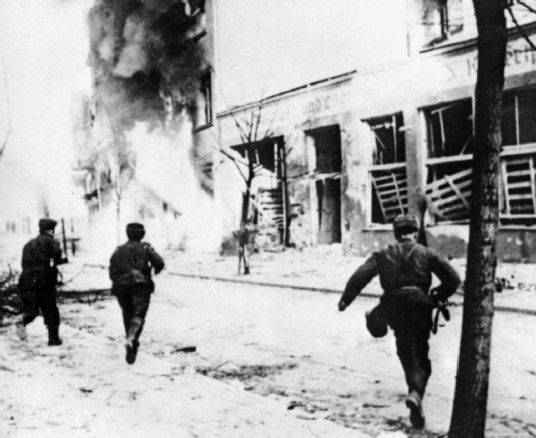
Street fighting in Gdynia
Taking Gdynia and Danzig
The Danzig-Gdynia defensive area was a tough nut to crack. The Gdynia fortified area consisted of two defense lines and had previously built long-term fortifications, artillery positions and observation posts, reinforced by an additional system of field fortifications, trenches, trenches and anti-personnel and anti-tank barriers. As a result, the city was protected by a solid defensive ring in the radius 12-15 km. The first line of defense had two positions consisting of five lines of trenches with a total depth of 3-5 km. The second lane was located a few kilometers from Gdynia and had three lines of trenches. The main defense of the Gdynia region was made up of strong anti-aircraft defense points (from 1943, the Germans created a powerful air defense system in the region to protect ports and fleets) and long-term defenses built by the Poles.
The city itself was prepared for street fighting. Almost all large stone buildings were turned into strong points. In such buildings, most of the window and door openings were laid with sandbags, stones, others were adapted for machine gun and artillery fire. Created firing positions for shooters. The basements were fitted as dugouts. Buildings and neighborhoods were connected by means of communication, by trenches so that they could support each other, maneuver their forces. The streets were blocked with barricades, mined them, installed reinforced concrete ridges, iron hedgehogs, built long-term firing points at crossroads. Many houses were prepared for demolition, guided mines were installed on the streets.
The Danzig fortified area also consisted of two field defense lines. The first line of defense consisted of five trench lines and was 3-5 km deep. The second line of defense was in 5-7 km from the city and with its flanks rested against the coast of the bay. It consisted of three positions. The first had from 2 to 4 trench lines with a total depth of up to 1,5-2,5 km, the second had two trench lines, plus strong points, and the third ran along the outskirts of the city. The outer belt of defense had two new fortified areas of Bischofsberg and Hagelsberg with reinforced concrete structures. From the southeast, the defense of Gdansk was strengthened by a system of old forts. In the defense of the city there were also new forts. Forts possessed powerful fire armament. Gdansk itself was also well prepared for street fighting. Gdansk-Danzig was one of the strongest "fortresses" of the Third Reich, and had to delay the advance of the Red Army for a long time.
In the junction between the Gdynia and Danzig fortifications, a defensive position was equipped with a number of strongholds with three trench lines. The Danzig-Gdynia defensive area had good anti-tank defenses: ditches, rubble, barricades, reinforced concrete bollards. Near the obstacles equipped single trenches for tank destroyers, armed with faustpronami. The defense was reinforced by stationary anti-aircraft and coastal batteries. The Germans had significant infantry forces, around 200 tanks and self-propelled guns, 180 artillery and mortar batteries, around 100 aircraft. In addition, the German 2 troops could support the fleet from the sea - several cruisers, destroyers, coastal defense ships and dozens of submarines and various boats.
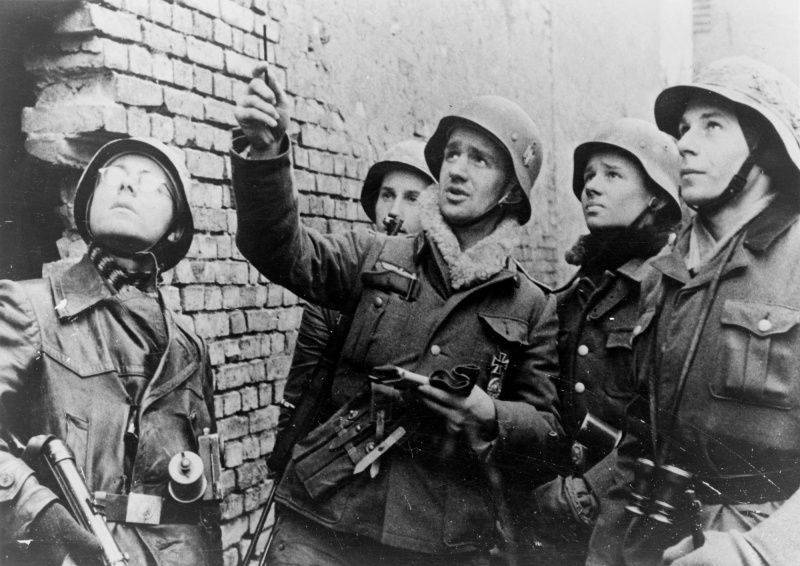
The militia of one of the battalions of the Volkssturm in Pomerania
Sturm central positions. In the morning of March 14 1945, after a short artillery preparation, Rokossovsky's troops continued the offensive. Fierce fighting went on day and night. The defense of the enemy had to literally gnaw. On some days, our troops could move only a few hundred meters. The struggle for some of the enemy's strongholds went on for several days. The Germans often switched to counterattacks, which were supported by fire by powerful artillery, including naval, as well as the Luftwaffe.
For example, such a battle went beyond the height of 205,8, which had four lines of trenches and four long-term reinforced concrete fire installations. The perimeter was covered by various obstacles, including solid minefields. All approaches were shot by artillery, mortars and machine guns. Individual buildings located in the 205,8 height area were prepared for defense. The height was of great importance, since it viewed the combat formations of our troops to a greater depth. At the same time, it is possible to view all German defenses up to the Danzig Bay, direct artillery fire at land and sea targets. An attempt by the 18 Guards Tank Brigade of the 3 Guards Tank Corps to take the height failed. March 15 had to enter the 2 th guards motorized rifle brigade in the second echelon. The first attacks of our troops, the Germans easily beat off machine-gun artillery fire. On the first day of the assault, motorized riflemen and tankmen could not advance.
The next day they decided to strike from several directions, some units were to distract the enemy, others to deliver the main attack. This tactic led to success. While the 2-th company under the command of the Kulakov 1-th motorized rifle battalion attracted the enemy, the 1-company of senior lieutenant Zadereeva was able to break into the first trench. Started hand-to-hand fight. At the same time, units of the 2 motorized rifle battalion under the command of captain Uvarov and senior lieutenant Deynogo broke into the enemy’s position. The commander of the 1 Company of the 1 Motorized Rifle Battalion, taking advantage of the fact that the German garrison was constrained by the battle in other directions, also attacked the enemy and broke into the second trench. During the many hours of battle by the end of the day, our troops captured the first two trenches. The next day, the whole day was a battle for the third trench, it was also taken. In the morning of 18, after a short artillery attack, our troops again launched an assault on enemy positions. Tanks and self-propelled guns reached the slopes of the height and with their fire on the embrasures of the combat fire installations suppressed enemy firing points. As a result, infantry and sappers were able to destroy the German pillboxes. The remains of the German garrison died under the rubble.
Thus, during an almost continuous three-day battle, our troops, at the cost of tremendous efforts, took enemy height, captured enemy soldiers and captured 300 guns, 10 mortars and 16 machine guns as trophies. This fight shows the conditions under which the storming of the German “fortress” took place.
Enemy aviation strongly interfered with the offensive operation. Therefore, 18 March was organized by the operation of the Soviet Air Force to destroy the enemy air force. Despite the bad weather, our planes dealt a powerful blow to German airfields. Our fighters blocked the airfields so that German planes would not take to the air, and the attack aircraft would strike the runways. The operation was successful, 64 of the enemy aircraft was destroyed. After that, the German army practically lost its air support, which facilitated the advance of our troops.
By March 24, the troops of the 49 and 70 armies broke through two lines of trenches, and reached the third and last line of fortifications. All day long Soviet artillery and aviation delivered powerful blows to enemy defenses. As a result, much of the defenses were broken. On the night of March 25, Soviet troops broke through the last line of defense of the enemy and in the morning broke into Zoppot. During the fierce battle, the city was taken and began the battle for the outskirts of Danzig.
Thus, by March 26, Soviet troops were able to break through the German defenses in the central sector and divide the Danzig-Gdynian group into two parts. Zoppot was captured. The German army was divided into three isolated groups in Danzig, Gdynia and on the Hel Spit.
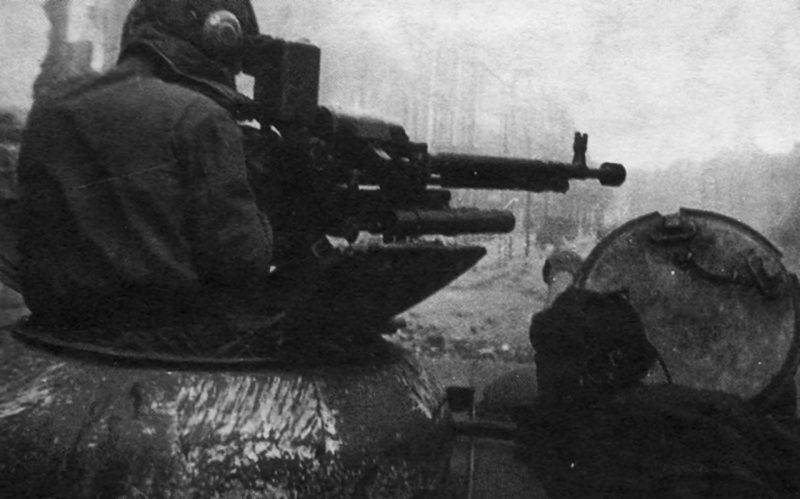
Soviet tankmen firing at the whistles from the DShK machine gun in Danzig
Storm of Gdynia. Meanwhile, Soviet troops attacked in the Gdynia region. The Gdynia Fortified Area defended 40, a thousand grouping that had about 100 tanks and self-propelled guns, about 80 artillery batteries. The coastal battery 12 guns and a dozen ships were constantly supported by ground forces. The Germans actively fought back, went on counterattacks, in some areas our troops repulsed 15-20 attacks per day. March 13 Soviet troops were able to break through the front line of defense and began storming the main positions. The rate of attack fell sharply. By 17 March, our troops penetrated the enemy's defenses and 23 March reached the last defense belt.
Since March 24, the Soviet troops have already fought for the villages closest to Gdynia, stormed the suburbs and the city itself. From that moment on, the army was taken to the rear and, from March 27, returned to the 1 of the Byelorussian Front. The troops of the 19 Army after a small regrouping continued the assault on the city. The first days of the battle went on with the same heat. I had to take one strong point after another, storm the buildings. However, after our troops took 26 blocks to 13 in March, the Germans broke. Their individual garrisons began to surrender without resistance or fled. Counterattacks have lost their former rage. The categorical order of the German command to stand to death has lost its force. The Germans fled or surrendered. On the night of March 27, German troops began their flight to the so-called. an oxheft bridgehead, which was prepared in advance for the event of a possible departure from the city. Another part of the Gdynia grouping, throwing heavy weapon, ammunition and equipment, hastily loaded onto ships. Organized defense collapsed, the Germans saved themselves as best they could.
As a result of March 28, Soviet troops, after days of stubborn fighting, took Gdynia and its suburbs. The remnants of the Gdynia grouping of the enemy, who fled the Oxheft bridgehead in a few days, were also eliminated. About 19 thousand people were taken prisoner. Soviet troops captured rich trophies, including 600 guns, more than 1 thousand machine guns, more than 6 thousand vehicles, 20 ships (including damaged 3 cruisers), etc.
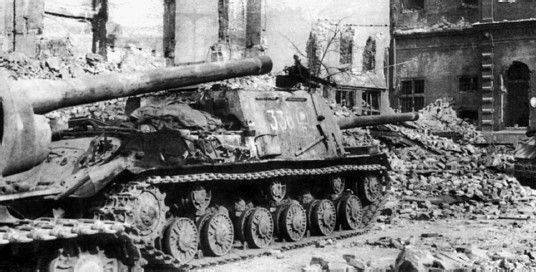
ISU-122 in Danzig
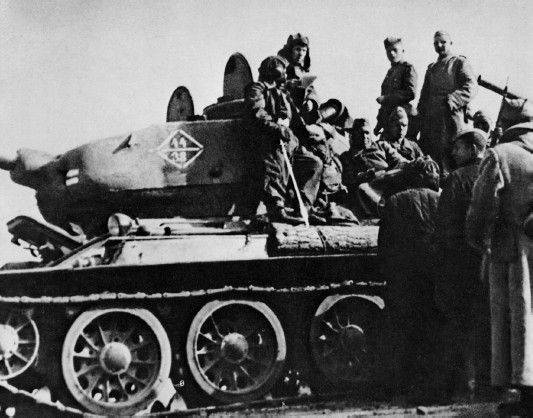
T-34-85 tank with infantry assault troops in the Danzig area
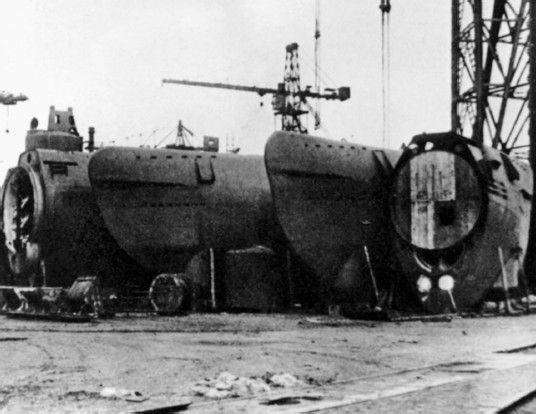
Uncompleted German U-boats captured by Soviet troops in Danzig
Sturm Danzig. Simultaneously with the intense battles in the Zoppot and Gdynia sectors, the Soviet troops stormed the fortifications of the Danzig defense region. The Germans stubbornly resisted, fiercely counterattacked. However, due to the success of the troops of the 70 and 49 armies in the central sector, enemy resistance weakened. The Germans began to lose one position after another. March 23 Soviet troops reached the second belt of defense of the enemy. Here the resistance of the German troops again increased. By the end of March 26, the troops of the 2 shock and the 65 armies broke through the enemy defenses at the final line, and reached the city.
27 March began a decisive assault on Danzig. Despite the impending doom of the German grouping trapped in the city, the Germans fought fiercely. Especially heavy fighting went for large buildings and buildings of factories. So for two days there was a battle for the territory of a chemical plant. With its strikes at fortified points, forts and bastions of the fortress, the Soviet aviation supported the ground forces of the German fleet. By 29 March, most of the city was cleared of the Nazis. 30 March the city and port were taken. The remnants of the German group fled to the area of the mouth of the Vistula, where they soon capitulated. About 10 thousand people were taken prisoner. About 140 tanks and self-propelled guns, 358 field guns, 45 defective submarines and other property were captured as trophies.
Thus, the troops of the 2 of the Byelorussian Front completely destroyed the enemy's Danzig-Gdynia grouping. 2-I German army was completely defeated. The eastern part of Eastern Pomerania was cleared of German troops. Soviet troops captured the strategic ports of Gdynia and Danzig. Germany lost its “fortress” and the large industrial center of Danzig. The Soviet Union returned to Poland the ancient Slavic city of Danzig (Gdansk).
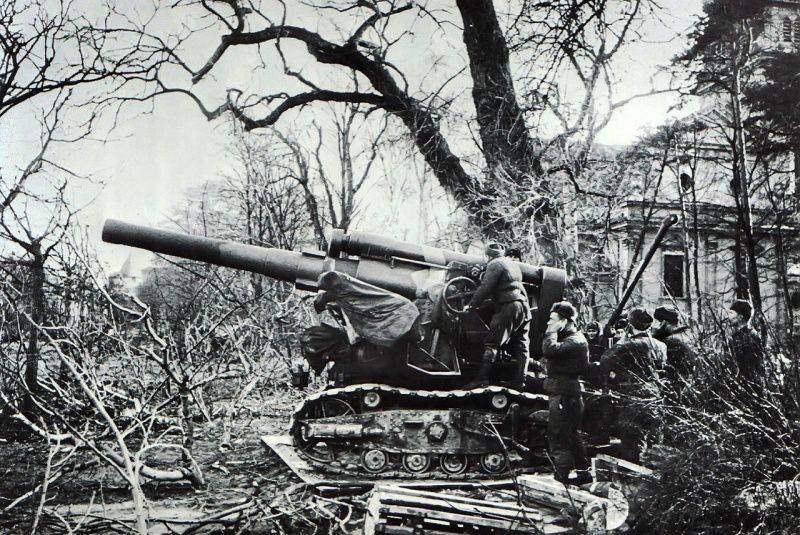
Howitzer B4 senior sergeant S. Shpinj during the storming of Danzig
Defeat of the Kolberg and Altdamian groups
Attacking Kolberg from the east, west and south, after several days of fighting, the Polish divisions cut off the German garrison from the sea and started a battle for the city itself. The Poles had no experience of urban battles, so the offensive developed slowly. However, 18 March 1945 g. Kolberg took. The German garrison was almost completely killed, its remnants capitulated.
In the Altdamm area, the fights were more intense. Here the Germans had a prepared defense and significant forces. March 14 after a strong artillery and aviation training, our troops launched a new offensive on the Altdam direction. Soviet aviation and artillery were able to suppress most of the first line of defense weapons and quickly broke through. However, as our troops advanced, German resistance increased dramatically. The Germans threw reserves into battle, brought a large amount of artillery into battle, including coastal batteries in the Stettin area. The rate of attack decreased. We had to fight to win every meter.
As a result of three-day brutal battles, Soviet troops broke through to the last line of defense. In order to inflict a last crushing blow on the enemy, the offensive was stopped for a while to regroup tanks and artillery. In the morning of March 18, after strong artillery preparation, the troops of the 61, 47, and 2 of the Guards Tank armies resumed the offensive. The Germans fought back, went on the counter. However, on March 19, the troops of the 47 and 2 tank armies broke through the enemy defenses and reached the Oder. As a result, the Altdamm grouping of the enemy was split into two parts, in the Altdamm area in the north and Greifenhagen in the south.
The German command made a desperate attempt to destroy our troops, wedged in their defense. The counter-strike was inflicted by two infantry divisions supported by large tank divisions. The Germans attacked in converging directions: from the Altdamm area to the south and from the Greifenhagen area to the north. However, success could not be achieved. In the oncoming battle, the counterattacking German troops suffered a heavy defeat. The Germans suffered serious losses.
Seeing the hopelessness of the situation, the German command began to withdraw troops for the Oder. 20 March, Soviet troops took Altdamm. On the same day, the troops of the 47 Army took Greifenhagen. The remains of the Altdam grouping fled to the right bank of the Oder. The Germans lost about 40 thousand people killed and 12 thousand people killed during the battle.
Thus, Zhukov’s armies defeated the enemy’s Koltsberg and Altdams groups. 11-I German army suffered a complete defeat. Enemy major strongholds Kohlberg (Kołobrzeg) and Altdamm were captured. Our troops cleared from the Nazis the western part of Eastern Pomerania. The entire eastern bank of the Oder was in the hands of the Soviet troops. The 1 Belorussian Front was able to concentrate the main forces on the Berlin direction.
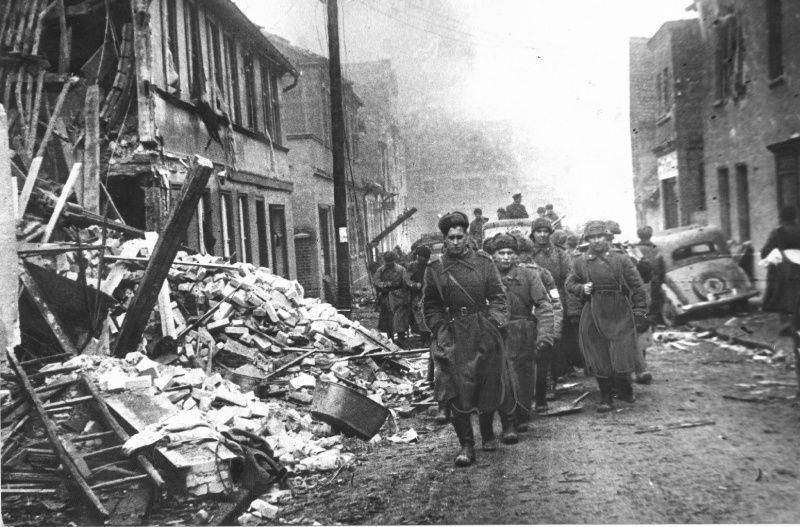
Soviet soldiers in Altdamme
Summary of the operation
The East Pomeranian operation ended with the complete victory of the troops of the 2 and 1 of the Belarusian Fronts. Army Group "Vistula" was defeated, its remnants retreated behind the Oder. The threat to the right flank and the rear of the 1 of the Byelorussian Front from the Eastern Pomeranian grouping was eliminated. The troops of the 1 of the Belorussian Front were able to focus all their efforts on the preparation of the Berlin operation. The troops of the 2 of the Byelorussian Front were also freed and were given the opportunity to attack Berlin.
Soviet troops and the Polish army liberated the ancient Slavic land - Eastern Pomerania (Pomorie). Our troops reached the coast of the Baltic Sea and the mouth of the Oder, such large centers as Elbing, Graudents, Danzig, Gdynia, Starogard, Stolp, Kozlin, Kolberg, Treptow, Stargard, Altdamm and others were occupied. The ancient Slavic region was returned to the Polish people with major industrial centers and ports in the Baltic.
Germany has lost an important industrial and agrarian base. The basing system of the Baltic Fleet and Soviet aviation was expanded. The blockade of German groups in East Prussia and Courland was intensified. Important sea communications were violated, which allowed them to support the Courland and East Prussian groups, which reduced their combat effectiveness.
The plans of the German command to organize a counterattack from the region of Eastern Pomerania and the delay of the war collapsed. The complete collapse of the Third Reich was fast approaching.
German troops only lost about 90 thousand people killed. About 100 thousand people were taken prisoner. About 5 thousand guns and mortars, more than 8 thousand machine guns, several warships, about five dozen submarines (defective) and many other equipment and military materials were taken as trophies. The total losses of the Soviet troops amounted to more than 225 thousand people (irrevocable - more than 52 thousand people).
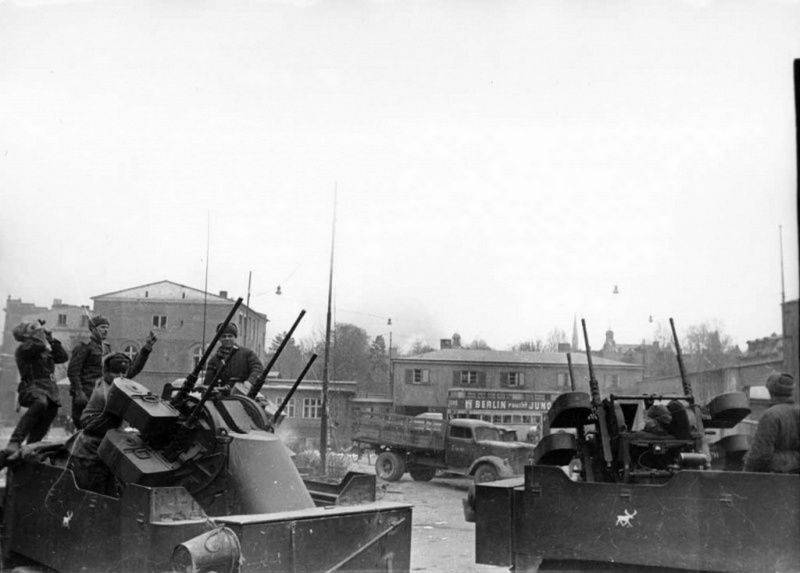
Anti-aircraft gunners of the 740 artillery regiment on M-17 armored personnel carriers on the street of the liberated Danzig
Sources:
Yemelyanov. Yu. V. Ten Stalinist strikes. The triumph of the generalissimo. M., 2006.
Zhukov G. K. Memoirs and reflections. The 2 T. T. 2. M., 2002.
Zavyalov A. S., Kalyadin T. Ye. East East Pomeranian offensive operation of the Soviet troops. February-March 1945 M., 1960 // http://militera.lib.ru/h/zavialov_kalyadin/index.html.
Isaev A. The rout of 1945. Battle of Germany. M., 2010.
Katukov ME On the edge of the main attack. M., 1974 // http://militera.lib.ru/memo/russian/katukov/index.html.
Rokossovsky K. K. Soldier debt. M., 1988 // http://militera.lib.ru/memo/russian/rokossovsky/index.html.
http://waralbum.ru/.
Part 1. East Pomeranian operation
Part 2. The offensive of the troops of the 2 of the Byelorussian Front: assault on Elbing and Graudents. Defeat of the Shneidemul Group
Part 3. The defeat of the army group "Wisla"
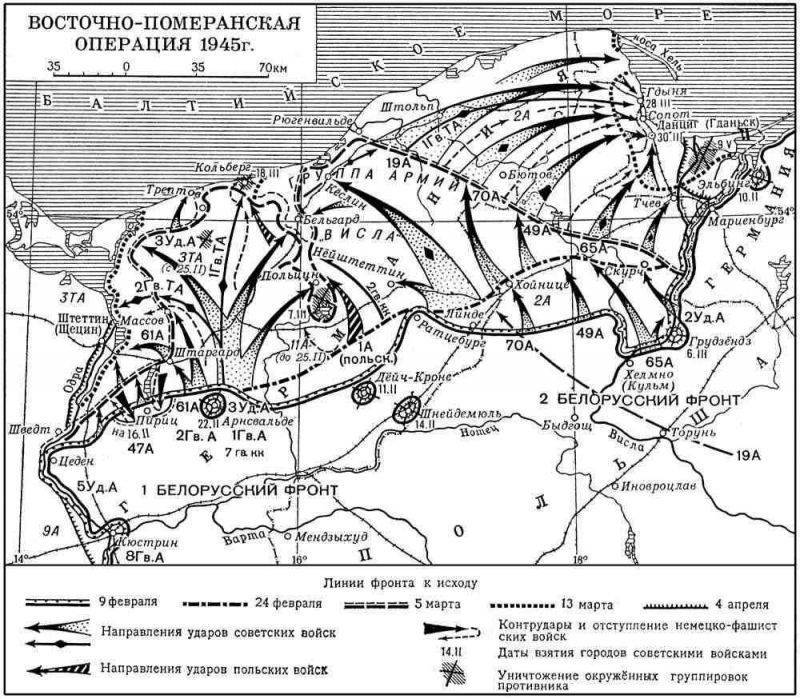
Information